Illex oxygonius
Michael Vecchione, Clyde F. E. Roper, and Richard E. YoungIntroduction
Illex oxygonius has the most restricted distribution of the four Illex species. Since its distribution includes a region of overlap between I. illecebrosus and I. coindetii, the possibility exists that I. onygonius could represent a hybrid of these two species (Roper, et al., 1998).
Characteristics
- Arms
- Normal (non-hectocotylized) arms
 Click on an image to view larger version & data in a new window
Click on an image to view larger version & data in a new window
Figure. Oral view of arm III of I. oxygonius, holotype, 207 mm ML. Drawing from Roper, et al. (1969).
- Hectocotylus (either left or right arm IV)
- Hectocotylized arm longer and more robust than opposite arm in fully mature animals.
- Distal hectocotylized portion of arm IV (HA3) moderately long, about 29% (24%-32%) of total arm length; 3 knobs and 2 slightly flattened papillae proximal to well-developed lamellae in dorsal row.
- Basal portion (HAb) of hectocotylized arm 4% of total arm length.
- Proximal portion (HA1) with 7 pairs of normal suckers.
- Middle portion (HA2) with sucker diameters reduced in size by about 1/4 on both rows; oral surface of arm constricted slightly between HA1 and HA2, but with no distinct reduction of arm musculature between normal and reduced sucker areas; rows normally separated; trabeculae not modified as fringed lobes.
 Click on an image to view larger version & data in a new window
Click on an image to view larger version & data in a new window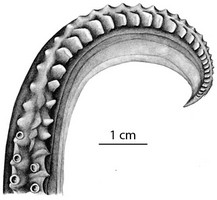
Figure. Oral view of the distal end of the hectocotylus of I. oxygonius, holotype, 207 mm ML. Drawing from Roper, et al. (1969).
- Normal (non-hectocotylized) arms
- Tentacles
- Head
- Head-width index high, 20.7 (19-23) in mature males, 17.8.
- Beaks: Descriptions and photographs can be found here: Lower beak; upper beak.
- Funnel
- Funnel/mantle locking-apparatus
- Funnel/mantle locking-apparatus
- Gladius:
- Fins
- "Fin angle in mature males acute, 25°-35°, occasionally 40°; fin width equal to fin length" Roper, et al., (1998)
.
- "Fin angle in mature males acute, 25°-35°, occasionally 40°; fin width equal to fin length" Roper, et al., (1998)
- Reproductive structures
- Spermatophore: "Spermatophore cone at oral end of cement body, funnel-shaped, with sides equal, broadly triangular in outline; oral tube relatively broad; aboral neck moderately short, narrow" (Roper, et al., (1998).
- Spermatophore: "Spermatophore cone at oral end of cement body, funnel-shaped, with sides equal, broadly triangular in outline; oral tube relatively broad; aboral neck moderately short, narrow" (Roper, et al., (1998).
Life History
Eggs, and paralarvae are unknown at present. Food is also unknown, but presumed to be crustaceans and fishes.

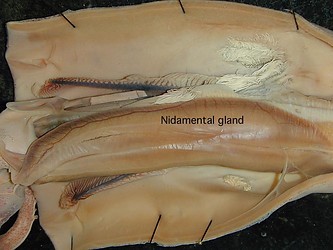
Figure. Ventral view of the cut-open mantle cavity of I. oxygonius. The nidamental glands are very large. White spermatangia are attached to the mantle walls and near an oviduct opening. Photograph by M. Vecchione.
Spawning grounds and season are unknown but circumstantial evidence suggests that mating may occur in the Gulf of Mexico near Key West, Florida (Vecchione, 2017).
Distribution
Type locality - Western North Atlantic off Key West, Florida at 24°13'N, 81°58'W.
Geographical distribution. I. oxygonius is found only in the western North Atlantic from off New Jersey (about 40°N) south to the Straits of Florida and the Gulf of Mexico but limits not well defined (Roper et al., 1998).


Figure. Distribution chart of all four species of Illex; modified from Roper et al. (1998).
References
Roper, C.F.E., C.C. Lu, and K. Mangold. 1969. A New Species of Illex from the Western Atlantic and Distributional Aspects of Other Illex Species (Cephalopoda: Oegopsida). Proceedings of the Biological Society of Washington, 82:295-322.
Roper, C.F.E., C. C. Lu, and M. Vecchione. 1998. Systematics and distribution of Illex species; a revision (Cephalopoda, Ommastrephidae). In: Voss, N.A., et al. (eds.) Systematics and Biogeography of Cephalopods. Smithson. Contr. Zool. 586:405-423.
Vecchione, M. 2017. http://oceanexplorer.noaa.gov/okeanos/explorations/ex1711/logs/welcome.html (click on: December 12: An End-of-life Event for Squid at the Beginning of the Cruise)
Title Illustrations

| Scientific Name | Illex oxygonius |
|---|---|
| Location | Gulf of Mexico near Key West, Florida at 815 m just above the sea floor. |
| Comments | Squid identification tentative. Background: Arm of ROV about to grab a soft coral. |
| Acknowledgements | Officers, crew, ROV operators and scientists of the NOAA R/V OKEANOS EXPLORER. |
| Specimen Condition | Live Specimen |
| Identified By | Michael Vecchione (based on circumstantial evidence) |
About This Page

National Museum of Natural History, Washington, D. C. , USA

Smithsonian Institution, Washington, D. C., USA

University of Hawaii, Honolulu, HI, USA
Page copyright © 2018 , , and
 Page: Tree of Life
Illex oxygonius .
Authored by
Michael Vecchione, Clyde F. E. Roper, and Richard E. Young.
The TEXT of this page is licensed under the
Creative Commons Attribution-NonCommercial License - Version 3.0. Note that images and other media
featured on this page are each governed by their own license, and they may or may not be available
for reuse. Click on an image or a media link to access the media data window, which provides the
relevant licensing information. For the general terms and conditions of ToL material reuse and
redistribution, please see the Tree of Life Copyright
Policies.
Page: Tree of Life
Illex oxygonius .
Authored by
Michael Vecchione, Clyde F. E. Roper, and Richard E. Young.
The TEXT of this page is licensed under the
Creative Commons Attribution-NonCommercial License - Version 3.0. Note that images and other media
featured on this page are each governed by their own license, and they may or may not be available
for reuse. Click on an image or a media link to access the media data window, which provides the
relevant licensing information. For the general terms and conditions of ToL material reuse and
redistribution, please see the Tree of Life Copyright
Policies.
- First online 13 January 2011
- Content changed 20 February 2018
Citing this page:
Vecchione, Michael, Clyde F. E. Roper, and Richard E. Young. 2018. Illex oxygonius . Version 20 February 2018 (under construction). http://tolweb.org/Illex_oxygonius/77446/2018.02.20 in The Tree of Life Web Project, http://tolweb.org/




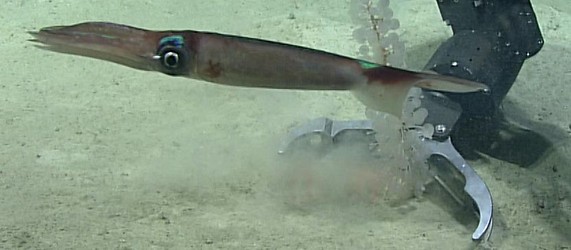
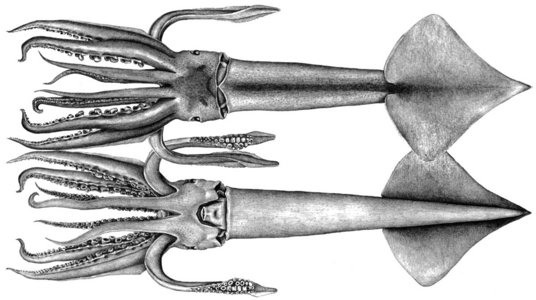



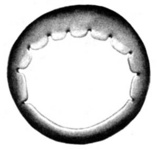
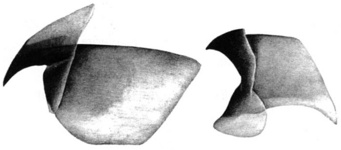
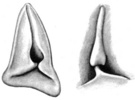


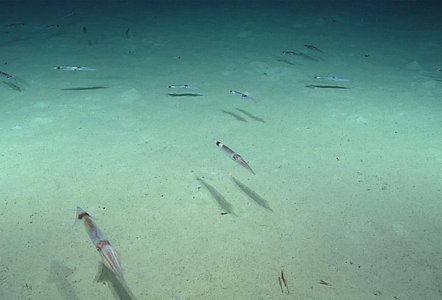
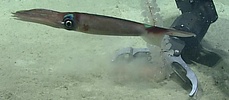


 Go to quick links
Go to quick search
Go to navigation for this section of the ToL site
Go to detailed links for the ToL site
Go to quick links
Go to quick search
Go to navigation for this section of the ToL site
Go to detailed links for the ToL site